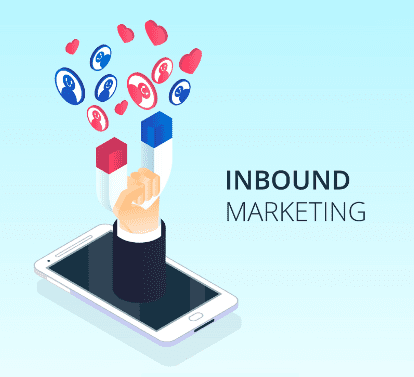Table of Contents
ToggleInbound marketing is a crucial strategy for driving traffic, generating leads, and increasing sales. Several tools can help make inbound marketing more effective.
- HubSpot: HubSpot is an all-in-one inbound marketing software that includes features such as email marketing, social media management, landing pages, and lead tracking. It also provides analytics and reporting tools to help businesses measure the success of their campaigns.
- Google Analytics: Google Analytics is a free tool that allows businesses to track website traffic, user behavior, and conversion rates. This information can be used to optimize marketing campaigns and improve website performance.
- Hootsuite: Hootsuite is a social media management tool that allows businesses to schedule posts, track engagement, and monitor brand mentions. It also provides analytics to help companies to measure the success of their social media campaigns.
- SEMrush: SEMrush is a keyword research and analysis tool that can help businesses optimize their content for search engines. It provides insights into the keywords and phrases people are searching for and information on competitor rankings and backlinks.
- Canva: Canva is a graphic design tool that can be used to create visually appealing social media posts, blog graphics, and other marketing materials. It offers a range of templates and design elements to help businesses create professional-looking designs even without a background in graphic design.
By leveraging these tools, businesses can streamline their inbound marketing efforts and maximize their ROI.
Introduction to Inbound Marketing
Inbound marketing is a customer-centric approach focusing on attracting and engaging potential customers through valuable content and experiences.
Unlike traditional outbound marketing tactics such as cold calling and mass advertising, inbound marketing seeks to attract customers by providing them with relevant and helpful information they are actively searching for.
The inbound marketing methodology typically includes four stages: attract, convert, close, and delight. In the attraction stage, businesses create blog posts, videos, and social media posts designed to attract potential customers to their websites.
In the convert stage, businesses offer something of value, such as a free e-book or webinar, in exchange for the visitor’s contact information. This allows companies to continue to nurture the lead and move them through the sales funnel.
In the close stage, businesses use marketing automation tools and personalized communication to close the deal and convert the lead into a paying customer. Finally, in the delight stage, companies continue to provide valuable content and experiences to the customer to build loyalty and encourage repeat business.
Inbound marketing is a customer-centric approach focusing on building relationships and providing value to potential and existing customers. By providing valuable content and experiences, businesses can attract, engage, and delight their audience, ultimately driving growth and success.
The benefits and challenges of using inbound marketing in marketing and sales efforts
Inbound marketing can be highly effective for businesses looking to drive growth and increase sales. However, it also presents some unique benefits and challenges.
Benefits of Inbound Marketing:
- Increased brand awareness: Inbound marketing can help businesses reach a wider audience by creating and promoting valuable content that attracts potential customers to their websites.
- Cost-effective: Inbound marketing can be a cost-effective alternative to traditional marketing tactics such as advertising and direct mail campaigns.
- Improved lead quality: Inbound marketing can help businesses attract high-quality leads more likely to convert by providing valuable content that potential customers are actively searching for.
- Increased customer loyalty: By providing lasting value and personalized experiences, businesses can build strong customer relationships, increasing loyalty and repeat business.
Challenges of Inbound Marketing:
- Time-consuming: Inbound marketing requires significant time and resources to create high-quality content, optimize website performance, and manage social media and other digital channels.
- Measuring ROI: While inbound marketing can be highly effective, measuring its impact on overall business performance and ROI can be challenging.
- Constantly evolving: Digital channels and consumer behavior are continually changing, requiring businesses to stay current with the latest trends and best practices to remain competitive.
- Requires a long-term view: Inbound marketing is not a quick fix; it requires a long-term investment in content creation, lead nurturing, and relationship building to achieve sustainable growth and success.
Despite these challenges, many businesses have found that inbound marketing can be a highly effective strategy for driving growth and increasing sales. By providing value and building customer relationships, businesses can create a sustainable competitive advantage and achieve long-term success.

Critical Tools for Effective Inbound Marketing
Inbound marketing can be a complex and time-consuming process, but several tools can help businesses optimize their inbound marketing efforts and achieve better results. Here are some of the critical tools for effective inbound marketing:
- Customer Relationship Management (CRM) Systems: CRM systems like HubSpot and Salesforce can help businesses manage customer relationships by providing a centralized platform for tracking customer interactions, lead nurturing, and sales pipeline management.
- Content Management Systems (CMS): CMS platforms like WordPress and Drupal make it easy for businesses to create and manage their website content, including blog posts, landing pages, and other marketing materials.
- Email Marketing Software: Email marketing software like Mailchimp and Constant Contact enable businesses to create and send targeted email campaigns, track open and click-through rates, and manage subscriber lists.
- Social Media Management Tools: Social media management tools like Hootsuite and Sprout Social allow businesses to schedule social media posts, monitor brand mentions, and track engagement metrics.
- Marketing Automation Software: Marketing automation software like Marketo and Eloqua can help businesses streamline their marketing processes by automating lead nurturing, email campaigns, and other repetitive tasks.
- SEO Tools: SEO tools like SEMrush and Ahrefs can help businesses optimize their website content for search engines, identify high-traffic keywords, and track their search rankings.
By leveraging these tools, businesses can streamline their inbound marketing efforts, improve their ROI, and achieve better results. However, it’s essential to choose the right tools for your business needs and invest in training and support to ensure your team can use them effectively.
Content Management Systems (CMS)
A Content Management System (CMS) is a software application that enables businesses to create, manage, and publish digital content such as web pages, blog posts, and marketing materials. CMS platforms typically provide a user-friendly interface that makes it easy for non-technical users to create and edit content without coding or web development skills.
Some popular CMS platforms include WordPress, Drupal, and Joomla. These platforms offer a range of features and functionality, including:
- Content creation and management: CMS platforms allow users to create and manage a wide range of digital content, including blog posts, landing pages, and multimedia content.
- Customizable templates: CMS platforms offer a range of templates that enable businesses to create visually appealing websites and marketing materials without needing web design skills.
- Collaboration and workflow management: CMS platforms allow multiple users to collaborate on content creation and editing and provide workflow management tools that help streamline the content creation process.
- SEO optimization: CMS platforms typically offer built-in SEO optimization tools that enable businesses to optimize their content for search engines and improve their rankings.
- E-commerce functionality: Many CMS platforms offer built-in e-commerce functionality that enables businesses to sell products and services online.
CMS platforms can be a highly effective tool for businesses creating and managing digital content, improving their online presence, and driving growth and success. However, it’s essential to choose the right CMS platform for your business needs and invest in training and support to ensure your team can use it effectively.
Search Engine Optimization (SEO) Tools
Search engine optimization (SEO) is a critical component of digital marketing, and a variety of tools are available to help businesses optimize their content and improve their search engine rankings. Here are some favorite SEO tools:
- Google Analytics: Google Analytics is a free tool that provides insights into website traffic and user behavior. It can help businesses track their SEO strategies’ effectiveness and identify improvement areas.
- SEMrush: SEMrush is a comprehensive SEO tool that offers a wide range of features, including keyword research, backlink analysis, and site audit reports.
- Ahrefs: Ahrefs is a popular SEO tool that provides insights into competitor rankings, keyword research, and backlink analysis. It also offers site audit reports to help businesses identify technical SEO issues.
- Moz: Moz is an all-in-one SEO tool with features like keyword research, site audit reports, and link analysis. It also offers a range of educational resources and SEO best practices.
- Yoast SEO: Yoast SEO is a WordPress plugin that provides on-page optimization tools, such as content analysis and keyword targeting. It also offers a range of features to help businesses optimize their website’s technical SEO.
By using these SEO tools, businesses can gain insights into their website performance, identify areas for improvement, and optimize their content for search engines. However, it’s essential to choose the right tool for your business needs and invest in training and support to ensure that your team can use them effectively.

Marketing Automation Platforms
Marketing automation platforms are software tools that help businesses automate repetitive marketing tasks like email campaigns, social media management, and lead nurturing.
These platforms typically use customer data and behavior to deliver personalized and targeted messages to customers and prospects at the right time and through the proper channels. Here are some popular marketing automation platforms:
- HubSpot: HubSpot is an all-in-one marketing automation platform that includes email marketing, lead management, social media management, and analytics. It offers a range of pricing plans to suit businesses of all sizes.
- Marketo: Marketo is a comprehensive marketing automation platform with features like lead management, email marketing, and landing pages. It also offers advanced analytics and reporting capabilities to help businesses measure the success of their campaigns.
- Pardot: Pardot is a marketing automation platform designed for B2B businesses. It offers features such as lead management, email marketing, social media management, analytics, and reporting tools.
- Eloqua: Eloqua is a marketing automation platform designed for enterprise-level businesses. It offers features such as lead management, email marketing, landing pages, and advanced reporting and analytics capabilities.
- ActiveCampaign: ActiveCampaign is a marketing automation platform offering email marketing, CRM, and lead management features. It also provides advanced segmentation and automation capabilities to help businesses deliver personalized messages to their audience.
By leveraging marketing automation platforms, businesses can streamline their marketing efforts, save time and resources, and deliver personalized and targeted messages to their audience. However, choosing the right platform for your business needs is essential, as investing in training and support ensures your team can use it effectively.
Customer Relationship Management (CRM) Systems
A Customer Relationship Management (CRM) system is a software application that enables businesses to manage customer relationships by providing a centralized platform for storing customer data, managing leads, and tracking sales pipelines. Here are some popular CRM systems:
- Salesforce: Salesforce is a cloud-based CRM system offering lead management, sales forecasting, and marketing automation features. It also provides a range of integrations with other business software, such as marketing automation platforms and accounting software.
- HubSpot: HubSpot offers a free CRM system with features such as lead management, email tracking, and sales pipeline management. It also provides a range of paid plans, including additional features such as marketing automation and customer service tools.
- Zoho CRM: Zoho CRM is a cloud-based system offering features such as lead management, sales pipeline management, and customer service tools. It also integrates with other business software, such as accounting and project management tools.
- Microsoft Dynamics 365: Microsoft Dynamics 365 is a cloud-based CRM system with features such as lead management, sales pipeline management, and customer service tools. It also integrates with other Microsoft business software, such as Microsoft Office and Microsoft Power BI.
- SugarCRM: SugarCRM is an open-source CRM system offering features like lead management, sales pipeline management, and marketing automation. It also provides a range of integrations with other business software, such as accounting and marketing automation tools.
Businesses can gain insights into their customer relationships, improve customer retention, and increase sales by using a CRM system. However, it’s essential to choose the right CRM system for your business needs and invest in training and support to ensure your team can use it effectively.
Email Marketing Tools
Email marketing is a highly effective tool for businesses looking to communicate with their audience, drive engagement, and increase sales. There are several email marketing tools available that can help companies to create and manage their email campaigns. Here are some popular email marketing tools:
- Mailchimp: Mailchimp is a popular email marketing tool offering features like email templates, marketing automation, and analytics. It also offers integrations with other business software, such as CRM and social media management tools.
- Constant Contact: Constant Contact is an email marketing tool offering features like email templates, list management, and social media integration. It also offers a range of educational resources and support to help businesses improve their email marketing efforts.
- Campaign Monitor: Campaign Monitor is an email marketing tool offering features like email templates, automation workflows, and analytics. It also offers integrations with other business software, such as CRM and e-commerce platforms.
- ActiveCampaign: ActiveCampaign is an email marketing tool offering features like email templates, marketing automation, and CRM integration. It also offers advanced segmentation and automation capabilities to help businesses deliver personalized messages to their audience.
- AWeber: AWeber is an email marketing tool offering features like email templates, list management, and marketing automation. It also integrates with other business software, such as CRM and e-commerce platforms.
By leveraging email marketing tools, businesses can create and manage effective email campaigns, track their effectiveness, and engage with their audience in a personalized way. However, it’s essential to choose the right tool for your business needs and invest in training and support to ensure your team can use it effectively.

Social Media Management Tools
Social media is a powerful tool for businesses looking to engage with their audience and increase brand awareness. However, managing multiple social media accounts can take time and effort. Here are some popular social media management tools that can help businesses streamline their social media efforts:
- Hootsuite: Hootsuite is a social media management tool that allows businesses to schedule social media posts, monitor brand mentions, and track engagement metrics. It also offers a range of analytics and reporting tools to help companies to measure the success of their social media campaigns.
- Buffer: Buffer is a social media management tool that allows businesses to schedule social media posts, track engagement metrics, and manage multiple social media accounts in one place. It also offers a range of analytics and reporting tools to help businesses measure the success of their social media campaigns.
- Sprout Social: Sprout Social is a social media management tool offering features such as scheduling, content creation, and analytics. It also provides collaboration and workflow management tools to help businesses manage their social media accounts more effectively.
- Later: Later is a social media management tool specializing in Instagram marketing. It allows businesses to schedule Instagram posts, track engagement metrics, and manage multiple Instagram accounts in one place. It also offers a range of analytics and reporting tools to help businesses measure the success of their Instagram campaigns.
- Agorapulse: Agorapulse is a social media management tool offering features such as scheduling, content creation, and analytics. It also provides a range of social media listening and monitoring tools to help businesses track brand mentions and respond to customer inquiries in real time.
By using social media management tools, businesses can streamline their efforts, save time and resources, and deliver engaging and effective campaigns. However, it’s essential to choose the right tool for your business needs and invest in training and support to ensure your team can use it effectively.
Analytics and Reporting Tools
Analytics and reporting tools are essential for businesses looking to measure the effectiveness of their marketing efforts, track key performance indicators (KPIs), and make data-driven decisions. Here are some popular analytics and reporting tools:
- Google Analytics: Google Analytics is a free tool that provides insights into website traffic and user behavior. It can help businesses track their SEO strategies’ effectiveness and identify improvement areas. It also offers a range of advanced analytics and reporting features, including custom dashboards and goal tracking.
- Adobe Analytics: Adobe Analytics is a comprehensive analytics tool that provides insights into website traffic, user behavior, and conversion rates. It also offers a range of integrations with other Adobe marketing tools, such as Adobe Experience Cloud and Adobe Target.
- Mixpanel: Mixpanel is an analytics tool that specializes in user behavior analytics. It allows businesses to track user behavior across multiple devices and platforms and provides insights into user engagement, retention, and conversion rates.
- Tableau: Tableau is a data visualization tool that allows businesses to create interactive dashboards and reports. It can help companies to make sense of complex data sets and identify trends and patterns.
- Databox: Databox is a reporting tool that allows businesses to create custom dashboards and reports using data from multiple sources. It offers integrations with a wide range of business software, including Google Analytics, HubSpot, and Salesforce.
By using analytics and reporting tools, businesses can gain insights into their marketing performance, identify areas for improvement, and make data-driven decisions. However, it’s essential to choose the right tool for your business needs and invest in training and support to ensure your team can use it effectively.
Best Practices for Implementing Inbound Marketing Tools
Implementing inbound marketing tools can be a powerful way for businesses to streamline their marketing efforts and improve their ROI. Here are some best practices for implementing inbound marketing tools:
- Define your goals and KPIs: Before implementing any inbound marketing tools, defining your goals and key performance indicators (KPIs) is essential. This will help you identify the right tools and metrics to track and ensure you’re measuring the right things.
- Choose the right tools: Many inbound marketing tools are available, and choosing the right ones is essential for your business needs. Consider budget, functionality, and ease of use when selecting tools.
- Invest in training and support: To ensure that your team can use inbound marketing tools effectively, it’s essential to invest in training and support. This may include providing access to online resources, attending training sessions, or hiring a consultant or agency.
- Integrate your tools: Inbound marketing tools are most effective when they work together. Ensure that your devices and other business software are integrated, such as CRM systems and e-commerce platforms.
- Continuously measure and optimize: Inbound marketing is an iterative process, and it’s essential to measure and optimize your efforts constantly. Use your analytics and reporting tools to track your KPIs, identify areas for improvement, and adjust your strategy accordingly.
By following these best practices, businesses can implement inbound marketing tools effectively, improve their marketing performance, and achieve their goals. However, it’s essential to be patient and persistent, as inbound marketing can take time to yield results.

Final Thoughts
Inbound marketing tools can be highly effective for businesses looking to improve their marketing performance, streamline their marketing efforts, and achieve their goals.
From content management systems to marketing automation platforms, email marketing tools, social media management tools, and analytics and reporting tools, a wide range of options are available to suit businesses of all sizes and needs.
To implement these tools effectively, you must define your goals and KPIs, choose the right tools, invest in training and support, integrate your devices, and continuously measure and optimize your efforts. By doing so, businesses can improve their online presence, engage with their audience in a personalized way, and drive growth and success.
- Success vs. Significance: Understanding the Difference and Achieving Both - October 1, 2023
- 8 Steps to SaaS Success: From Idea to Business - September 30, 2023
- The Importance of Testing in SaaS: Ensure Quality and Success - September 29, 2023